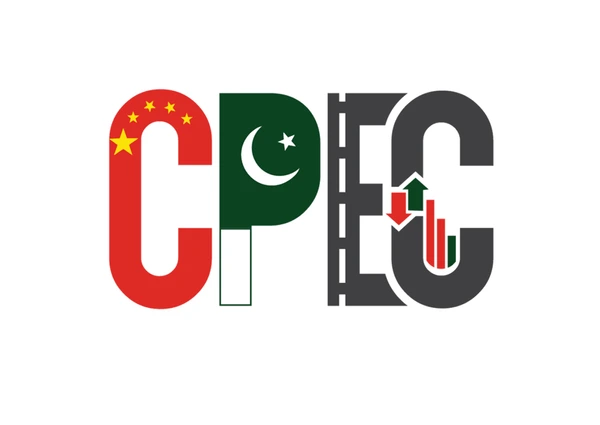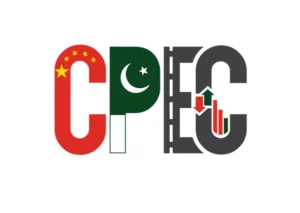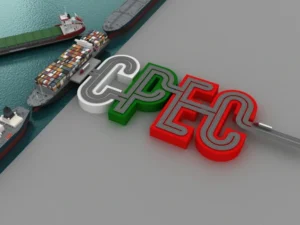
China-Pakistan Economic Corridor (CPEC): Achievements and Failures
The China-Pakistan Economic Corridor (CPEC) stands as a testament to the ambitious vision of the Belt and Road Initiative, aiming to transform the economic landscape by connecting Gwadar Port in Pakistan to China’s north-western city of Kashgar. Over the past decade, CPEC has witnessed both remarkable achievements and formidable challenges, shaping the socio-economic dynamics of the region.
CPEC is the pioneer project of China’s grand project, the Belt and Road Initiative (BRI). BRI aims to pave the way for economic cooperation and inter-regional connectivity that will lead to collective prosperity. China has promised investments through CPEC totaling $62 billion. Both China and Pakistan call CPEC a win-win initiative, providing much-needed infrastructure to Pakistan and shortening trade routes for China with direct access to the Indian Ocean through Gwadar port. Pakistan’s leadership labeled the project a ‘game changer’ and ‘fate changer’ that would transform the country’s development and economic trajectory by enhanced regional connectivity.

One of the six economic corridors planned under the BRI, CPEC is distinctive for various reasons. First, CPEC is the only corridor where the overland Belt and maritime Road meet at Gwadar, a port city strategically located not far away from Iran’s Chabahar Port and the Strait of Hormuz, one of the world’s most strategically important choke points where 30 percent of the global seaborne-traded crude oil passes every day (S&P Global Commodity Insights, 2018). Second, unlike other BRI corridors, CPEC is a ‘one-country corridor’ where all infrastructure projects traverse Pakistan without involving a third country. Third, the corridor has accomplished several milestones as many projects have been completed.
Thus far, CPEC projects have directly or indirectly generated 200,000 jobs in Pakistan, added over 6,000 MW of electricity to the national grid, built about 809 km road infrastructure and installed 886 km power transmission lines. Thus, CPEC has made substantial progress as numerous projects have been completed across Pakistan, including the first metro line in Lahore, Pakistan’s second most populous city. Another 36 projects worth USD 28.4 billion are in the pipeline.
Concerning the goal of regional connectivity, Pakistan’s location at the cusp of Central, South and West Asia makes it ideally suited to become a hub of trade and logistics. The country provides the shortest land link to Central Asian countries to reach warm waters – Pakistani shores are about 2600 km via Afghanistan as compared to Iran (4500 km) or Turkey (5000 km). China and Pakistan also want to integrate Afghanistan into CPEC to ensure stability in the region and to promote their economic interests. While all three countries have agreed to the proposal, a concrete roadmap is yet to be developed.

India’s willingness to join CPEC/BRI could also revive moribund initiatives such as the Turkmenistan, Afghanistan, Pakistan, and India (TAPI) gas pipeline and the Central Asia-South Asia (CASA) power project involving Kyrgyzstan, Tajikistan, Afghanistan, and Pakistan. There is significant potential to connect energy-rich Central Asian states with heavily populated energy-starved South Asian countries, and China has the wherewithal to assist in these initiatives.
The Targets of CPEC under BRI
- Infrastructure Development: CPEC aimed to transform Pakistan’s infrastructure by constructing modern transportation networks, including highways, railways, ports, and airports. The goal was to enhance regional connectivity and facilitate trade and economic growth.
- Energy Security: Addressing Pakistan’s energy crisis was a core objective of CPEC. The corridor aimed to develop various energy projects, including coal, hydro, solar, and wind power plants, to boost the country’s energy capacity and reduce its dependence on costly energy imports.
- Economic Growth and Industrialization: CPEC aimed to stimulate Pakistan’s economic growth by attracting foreign direct investment (FDI) from China. This investment was expected to create job opportunities, spur industrialization, and improve living standards for the Pakistani people.
- Regional Connectivity: As part of the Belt and Road Initiative, CPEC envisioned fostering regional connectivity by creating a network of roads, railways, and pipelines linking China to the Arabian Sea through Gwadar Port. This connectivity aimed to benefit China, Pakistan, and landlocked Central Asian countries.
Structural Planning of CPEC has Following Four stages:
- Early Harvest 2015-2018: Most of the projects related to the Energy sector,completed or expected to be completed by 2018, had approximately 5,000 MW of electricity added to the national grid and thus easing the energy shortages and load shedding that had crippled the industry and exports.
- Short-term projects up to 2020: Roads, Gwadar Development, Optic fiber network and the Hydel, coal mining, and power projects.
- Medium projects up to 2025: Railways and Industrial zones.
- Long-term projects up to 2030: Completion of Industrial zones, Agriculture, Tourism, Science and Technology, Information Technology, Water Resources, Oil and Gas Sector, Mines and minerals, and Socioeconomic based grant projects.
Achievements of CPEC:
- Infrastructure Development:
CPEC’s most significant achievement lies in the extensive development of infrastructure. The construction of highways, railways, and energy pipelines has not only enhanced connectivity between China and Pakistan but has also laid the foundation for regional economic integration. The creation of a robust network facilitates smoother trade routes and positions the corridor as a pivotal player in the Belt and Road Initiative. Moreover, 4 of a total of 14 projects to develop the Gwadar Port have been completed, including Gwadar Port and free-zone, Gwadar Smart-port city master plan, Pak-China Technical and Vocational Institute at Gwadar, Pak-China Friendship Hospital and Gwadar Eastbay Expressway.
- Energy Contribution:
A noteworthy success of CPEC is its contribution to addressing Pakistan’s energy crisis. The development of energy projects, including coal power plants and hydropower dams, has added approximately 6000 megawatts to the national grid. This infusion of power has not only met domestic demands but has also fostered a more stable environment for industrial growth, aligning with the initiative’s goals of shared prosperity. One (01) energy project, 884 MW Sukki-Kinari HPP, is expected to be completed in July 2024. In addition, 700.7 MW Azad Pattan Hydro Power projects, 1,124 MW Kohala, and 300 MW Gwadar Coal Power Project are in the pipeline (Centre for Research and Security Studies).
- Economic Boost and Foreign Direct Investment (FDI):
CPEC has injected vitality into Pakistan’s economy through substantial foreign direct investment (FDI). With China investing $25.4 billion in various sectors, including infrastructure and industry, the corridor has become a catalyst for economic growth. Job creation and poverty reduction have been tangible outcomes, reflecting the collaborative spirit of the Belt and Road Initiative. 4% growth CPEC related. 17.7 billion dollars trade between china and Pakistan.
- Strategic Geo-Economic Positioning:
Strategically, CPEC has positioned Pakistan as a key player in regional economic dynamics. The Gwadar Port’s development has strengthened Pakistan’s role as a trade hub, providing a gateway for Chinese exports and imports. The corridor’s potential expansion to connect other countries could stimulate a broader economic and trade boom, amplifying Pakistan’s geopolitical significance.
- Strengthening Pak-China Relations:
CPEC has played a pivotal role in strengthening the diplomatic and economic ties between Pakistan and China. Based on principles of equality and all-weather friendship, the collaboration has demonstrated China’s commitment to peaceful relations and non-intervention in internal affairs. The corridor’s success has deepened the bond between the two nations, setting a positive precedent for future collaborations.
- Connectivity and Trade Facilitation:
CPEC has significantly improved connectivity, not only between China and Pakistan but also with the potential to link other countries in the region. The economic corridor has facilitated smoother trade routes, reducing the distance for Chinese exports and imports. This enhanced connectivity is poised to stimulate economic activities, creating a ripple effect of growth in the entire region. In the early harvest projects of CPEC, six mega infrastructure projects were completed; Havelian-Thakot section of KKH, Multan-Sukkur (M-5) Motorway, Hakla-D.I.Khan Motorway, Optical Fiber Cable, Eastbay Expressway, and Orange Line Metro Train.
- International Collaboration and Investment:
CPEC has attracted international attention and collaboration, with various countries expressing interest in participating in the project. The corridor’s success has instilled confidence in countries along its routes, paving the way for increased collaboration and investment. This international engagement reflects the transformative potential of CPEC beyond the immediate region.
Failures of CPEC:
Since its launch, CPEC has faced multiple challenges. The initiative is divided into three phases. The short-term phase (2015-2022), the medium-term phase (2021-2025), and the long-term phase (2026-2030). The first phase of CPEC focused on infrastructure, energy, and port development projects. However, corruption in Pakistan hampered smooth progress. The second phase of CPEC aims to establish 33 special economic zones (SZEs) with nine zones to begin with. The projects in this phase have also seen delays. Pakistan’s political instability, financial crisis, and terrorism have all limited the implementation of CPEC projects over the past ten years. These challenges persist to this day, worsened by current political and economic instability and the resurgence of terrorism following the US troop withdrawal from Afghanistan. While the third phase has yet to commence formally, the first two phases are unlikely to reach completion with the prevailing situation in the country.
- Security Challenges and Insurgent Threats:
Despite its achievements, CPEC faces significant security challenges. Ongoing terrorist attacks targeting Chinese nationals and infrastructure projects, particularly in the Balochistan province, have disrupted the project’s progress. The security concerns pose a formidable threat to the corridor’s long-term sustainability and impact on regional stability. CPEC has also exacerbated existing fault lines in society, leading to an increase in violence. Insecurity in Balochistan has grown to such a level that the Chinese and their installments have become the target of frequent attacks by Baloch separatist outfits. For example, in 2018 terrorists from the Baloch Liberation Army attacked a Chinese consulate in Karachi, which was luckily foiled by the police. Likewise, four terrorists from the banned Baloch Liberation Army stormed the Pakistan Stock Exchange in 2020 where the Chinese have major investments. Moreover, in 2022 a suicide bomb blast by a female suicide bomber, Shari Baloch alias Bramsh, outside Karachi University, was aimed at Chinese nationals. In this suicide blast, three Chinese nationals were killed. In yet another incident this year, the Baloch Liberation Army set 6 Chinese mobile towers on fire. These incidents and their frequency show the extent to which CPEC has fomented insurgency in Balochistan.
- Economic Distress and Debt Crisis:
A critical failure lies in CPEC’s inability to alleviate Pakistan’s chronic economic distress. The country’s external debt, soaring to $126 billion, with a substantial portion owed to China, raises concerns about a potential default. Despite substantial investments, Pakistan’s economic indicators, including rising inflation and a high poverty rate, indicate persistent challenges. China holds USD $30 billion of Pakistan’s USD $126 billion external foreign debt.
- Political Skepticism and Corruption Allegations:
A shift in political leadership in 2018 brought skepticism about CPEC’s alignment with Pakistan’s national interests. The Khan government expressed concerns and alleged corruption within Chinese companies involved in CPEC projects. This political skepticism has introduced a layer of complexity to the collaboration, potentially impacting the continuity of certain projects. Besides this, Pakistani political figures have used CPEC for political purposes and continue to do so. For instance, the outgoing Prime Minister Shehbaz Sharif recently accused the former PM Imran Khan of halting progress on CPEC and damaging relations with China. With Pakistan’s elections approaching, further politicization of CEPC is all but guaranteed.
- Unfulfilled Economic Turnaround:
CPEC has not resulted in the anticipated economic turnaround for Pakistan. Despite the infusion of foreign direct investment and substantial projects, the country continues to grapple with economic challenges. The promises of job creation and poverty reduction have not materialized to the extent expected, leaving many Pakistanis struggling with the economic aftermath.
- Regional Disparities and Public Resentment:
CPEC’s impact on regional development has been marred by the perception of regional disparities. The focus on more developed provinces, such as Punjab and Sindh, has fueled public resentment, raising questions about the equitable distribution of benefits. Balancing regional development remains a challenge, potentially leading to increased dissatisfaction among the local populace. Pakistanis have criticized CPEC for benefiting China more than Pakistan. For instance, the Gwadar Haq Do Tehreek protested the differential treatment of the people of Gwadar despite being at the center of CPEC and asked the provincial government to provide the residents of Gwadar access to electricity and education, remove the check posts, and take action against the Chinese trawler mafia.
- Slow Progress and Implementation Hurdles:
The progress of CPEC has been slower than anticipated, encountering implementation hurdles and delays. The bureaucratic and administrative challenges, coupled with security concerns, have impeded the seamless execution of projects. These slow-paced advancements pose risks to the timely realization of the corridor’s full potential. While CPEC promised to create 2.3 million jobs in Pakistan by 2030, by the end of 2022 it only managed to create 236,000 jobs out of which only 155,000 went to Pakistani workers. Out of the nine approved SZEs, four are still under construction and five are yet to be launched. The Pak-China Friendship Hospital, which was meant to create a state-of-the-art medical facility in Gwadar, was set to be completed by December 2022. However, it has not been completed yet and is projected to be completed by October 2023. Moreover, in the energy sector, the 884MW Suki Kinari Hydropower Project was to be made operational by 2022. Unfortunately, the project is still only 70 percent complete. There are six other energy-related projects under construction, with no certain dates of completion. Of the transport infrastructure projects, only six are completed, five are under construction, and thirteen are yet to start. While these are some of the major projects that are long overdue, CPEC has faced numerous other disappointments. Also, little progress has been made on proposed railway projects. For example, the Karachi-Peshawar railway line, known as Main Line-1 (ML-1) has not made any headway. Due to multiple delays and slow progress the cost soared by $3 billion to $9.9 billion.
- Environmental Concerns and Sustainability:
CPEC projects have faced criticism for their environmental impact, particularly in terms of ecological disruption and sustainability. The construction of coal power plants and the associated environmental consequences have raised concerns about the long-term viability of certain projects. Addressing these environmental challenges is crucial for ensuring the sustainability of CPEC initiatives.
Countering Challenges and the Way Forward
- Multifaceted Approach: To address the challenges encountered by the China-Pakistan Economic Corridor (CPEC), a comprehensive strategy is essential. This strategy should encompass various aspects such as enhancing security measures, fostering regional cooperation, and tackling environmental concerns.
- Strengthening Security Measures: One of the key components of countering challenges in CPEC is the bolstering of security measures. Ensuring the safety of infrastructure, personnel, and investments is imperative to maintain the project’s integrity and continuity.
- Enhancing Regional Cooperation: Another crucial aspect involves enhancing cooperation among regional stakeholders. Collaboration between China, Pakistan, and neighboring countries can contribute significantly to overcoming geopolitical and security challenges associated with CPEC.
- Addressing Environmental Concerns: Environmental sustainability is a pressing issue that must be addressed. Measures to mitigate environmental degradation and promote eco-friendly practices within the CPEC framework are essential for long-term viability and public acceptance.
- Fostering Transparent Governance: Transparent governance practices are essential for building public trust and confidence in the initiative. Ensuring accountability, fairness, and transparency in decision-making processes can help alleviate concerns and garner support from stakeholders.
- Mitigating Political Skepticism: Open dialogue and communication are vital for mitigating political skepticism surrounding CPEC. Engaging with diverse political factions and addressing their concerns can help foster a conducive environment for the project’s success.
- Ensuring Equitable Distribution of Benefits: Equitable distribution of benefits is crucial for ensuring widespread support for CPEC. Efforts to ensure that the benefits of the project reach all segments of society can help mitigate disparities and foster inclusive growth.
- Collaboration and Engagement: Collaborative efforts between China, Pakistan, and the international community are essential for navigating the complex landscape of challenges. Continued engagement with relevant stakeholders will be crucial for overcoming obstacles and realizing the transformative potential of CPEC.
- Learning from Experience: As CPEC enters its second decade, it is essential to learn from both successes and failures. Incorporating lessons learned into future strategies will be critical for ensuring sustainable development and maximizing the project’s positive impact on the entire region.
Addressing Misconceptions and Moving Forward
- Clarifying Intentions: It’s important to clarify misconceptions surrounding CPEC, particularly regarding debt traps and intentions behind investments. The Government of China and CPEC state-owned companies have no ill intentions towards Pakistan, and allegations from Western donors like the IMF should be addressed through transparent communication.
- Importance of Proper Governance: Effective governance is paramount for maximizing the benefits of CPEC investments. Pakistan’s internal political unrest has hindered progress and eroded trust among investors. Ensuring stability and efficiency in governance is essential for harnessing the potential of CPEC to boost the economy.
- Managing Debt and Financial Responsibilities: Debt is an inherent aspect of development projects, and managing it responsibly is crucial. Pakistan must balance its financial obligations while leveraging investments from China effectively. Collaboration with international financial institutions should be pursued cautiously to avoid detrimental consequences.
- Seizing Opportunities for Economic Growth: CPEC presents significant opportunities for economic growth and development. However, seizing these opportunities requires concerted efforts to address internal challenges and leverage external support effectively. By putting its house in order, Pakistan can fully realize the potential of CPEC for sustainable economic advancement.
Admin at The Pakistan Gazette

